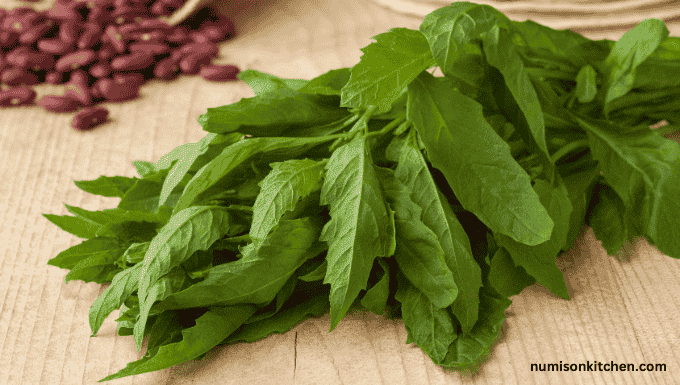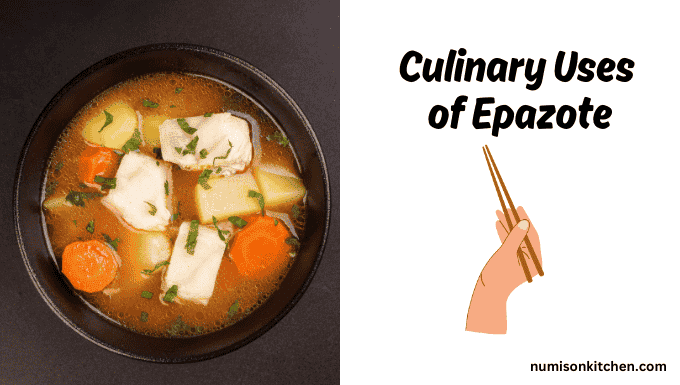The first time I encountered epazote, I had no idea what it was. I was at a local Mexican market, scanning the fresh herbs section when a vendor handed me a bundle of long, jagged leaves and said, “If you love cooking black beans, you need this.” Intrigued, I took it home, and as soon as I tore a leaf, a bold, earthy aroma filled my kitchen—something between mint, anise, and even a hint of gasoline. It was unlike any herb I had ever used!
After experimenting with epazote in traditional dishes like black beans (here’s a great guide) and quesadillas (see how to make them here), I realized why it’s a staple in Mexican cooking. Not only does it add a distinct, slightly peppery flavor, but it also helps reduce gas when cooking beans—a well-known trick passed down through generations. But there’s more to epazote than just flavor. This powerhouse herb has been used in traditional medicine for centuries, and if you’re into growing your own herbs, it’s incredibly easy to cultivate.

In this guide, I’ll walk you through everything you need to know about epazote—what it is, how to use it, its health benefits, and even some simple recipes to try. Whether you’re new to this herb or just looking for more ways to use it, you’re in for a treat. Let’s dive in!
What is Epazote?
I still remember the first time I heard about epazote—a friend who grew up in Mexico told me, “You can’t cook black beans the right way without it.” At first, I thought it was just another leafy herb, but as soon as I smelled it, I knew this was something special.
Epazote (Dysphania ambrosioides) is a bold, aromatic herb commonly used in Mexican and Central American cuisine. It has a strong, almost medicinal scent—some say it smells like a mix of oregano, anise, citrus, and even gasoline! But don’t let that scare you off. This unique herb adds a deep, earthy flavor to dishes, making it a favorite ingredient in traditional recipes like soups, stews, tamales, and black beans (learn more about black bean cooking here).
What Does Epazote Look Like?
If you’ve never seen epazote before, you might mistake it for a wild plant. It grows as a tall, leafy green with jagged, elongated leaves and can reach up to three feet high. When fresh, the leaves are bright green and slightly crinkled. The plant thrives in warm climates and is often found growing wild in Mexico and parts of the southern United States.
What Does Epazote Taste Like?
Describing the taste of epazote is tricky because it doesn’t compare to common herbs like basil or cilantro. It has an intense, slightly peppery, citrusy, and medicinal flavor with a hint of bitterness. Because of its strong profile, a little goes a long way—too much can overpower a dish. But when used in the right amount, it enhances flavors beautifully.
A Staple in Mexican Cooking
In traditional Mexican cuisine, epazote is as essential as cilantro or oregano. It’s particularly famous for its role in cooking black beans, as it not only boosts flavor but also helps reduce bloating and gas. It’s also a key ingredient in quesadillas, moles, tamales, and certain seafood dishes.
Whether you’re new to epazote or looking to deepen your knowledge of Mexican herbs, this powerhouse ingredient is worth exploring. In the next section, I’ll share how to use epazote in your cooking—including my personal tips for getting the best flavor out of it!
Culinary Uses of Epazote

When I first started cooking with epazote, I was a little unsure of how to use it. Its bold, almost medicinal aroma made me wonder if it would be too overpowering. But after adding just a few leaves to a pot of black beans, I understood why this herb is a staple in Mexican cuisine. It transformed the dish, giving it a rich, earthy depth that I had never tasted before.
Epazote is more than just a flavor booster—it plays a vital role in many traditional Mexican and Central American dishes. Let’s explore some of the best ways to use this unique herb in your cooking.
1. Cooking Beans with Epazote (The Ultimate Secret Ingredient)
One of the most well-known uses of epazote is in black beans. If you’ve ever struggled with digestive issues after eating beans, this herb is your new best friend. It has long been used to reduce bloating and gas, thanks to its natural carminative properties.
👉 How to Use:
- Add 2–3 fresh epazote leaves (or about 1 teaspoon dried epazote) to a pot of simmering black beans, pinto beans, or lentils.
- Let it cook with the beans to infuse its flavor and digestive benefits.
- Remove the leaves before serving, just like you would with a bay leaf.
2. Epazote in Quesadillas & Tacos
If you love quesadillas, you have to try them with epazote. This herb is commonly used in Mexican street-style quesadillas, where it’s paired with Oaxaca cheese, mushrooms, and squash blossoms (see a great quesadilla recipe here).
👉 How to Use:
- Chop a few fresh leaves and sprinkle them inside your quesadilla before cooking.
- It pairs especially well with mushrooms, cheese, and huitlacoche (corn truffle).
- For tacos, try adding a small amount of finely chopped epazote to grilled meats, seafood, or roasted vegetables for an earthy kick.
3. Flavoring Soups, Stews, and Moles
Because of its bold and slightly peppery taste, epazote is often used to season rich, hearty dishes like soups, stews, and moles.
👉 How to Use:
- Add a few whole leaves to simmering chicken soup, pozole, or tortilla soup.
- Use dried epazote as a seasoning in mole sauces to enhance their complexity.
- Mix fresh epazote into seafood stews—it pairs particularly well with shrimp and fish-based soups.
4. Tamales & Traditional Mexican Dishes
In Mexico, epazote is often mixed into the masa (corn dough) used for making tamales. It gives them an extra depth of flavor that complements spicy salsas and rich fillings.
👉 How to Use:
- Add chopped epazote leaves to the tamale dough for a subtle, earthy taste.
- Use it as a seasoning in chile-based sauces to enhance the traditional flavors.
How Much Epazote Should You Use?
Since epazote has a strong taste, a little goes a long way. For fresh epazote, start with one or two leaves per dish and adjust based on your preference. If using dried epazote, about ½ to 1 teaspoon is usually enough for a pot of beans or a stew.
Cooking with epazote has completely changed the way I make Mexican food. It’s one of those “secret ingredients” that you don’t know you need until you try it. Whether you’re adding it to beans, quesadillas, soups, or tamales, this herb brings an authentic depth of flavor that makes dishes taste truly Mexican.
Health Benefits and Precautions

I first started using epazote because of its bold flavor, but I quickly learned that this herb is more than just a kitchen staple—it’s also packed with health benefits. In fact, many people in Mexico and Central America have been using epazote for centuries as a natural remedy for digestion, parasites, and even respiratory issues. But, like with any powerful herb, it’s important to use it in moderation to avoid any unwanted side effects.
Traditional Health Benefits of Epazote
For generations, epazote has been known for its medicinal properties, particularly in aiding digestion. Here are some of its most well-known benefits:
✅ Reduces Gas and Bloating – One of the biggest reasons people add epazote to black beans (learn more about cooking black beans) is because it helps prevent bloating. This is thanks to its natural carminative properties, which help reduce gas buildup in the stomach.
✅ Supports Digestive Health – In traditional medicine, epazote has been used as a natural remedy for stomach cramps, indigestion, and upset stomach. Drinking epazote tea is a common practice in some cultures to help soothe digestive discomfort.
✅ May Help Expel Parasites – The name “epazote” actually comes from the Nahuatl language, meaning “skunk sweat”, referring to its strong aroma. Historically, the herb was used as a natural antiparasitic treatment to help expel intestinal worms. While modern medicine provides more effective treatments, some people in rural areas still use epazote as a traditional remedy.
✅ Rich in Antioxidants – Like many herbs, epazote contains antioxidants, which help fight inflammation and support overall health. It also provides small amounts of vitamins A, B, and C.
Important Precautions When Using Epazote
While epazote has impressive health benefits, it’s important to use it in small amounts. This is because the herb contains ascaridole, a compound that can be toxic in large quantities.
⚠️ Avoid Consuming Large Amounts – Using a few leaves in cooking is perfectly safe, but consuming large doses—especially in concentrated epazote tea or extracts—can lead to nausea, dizziness, or other side effects.
⚠️ Not Recommended for Pregnant Women – Traditional medicine has long warned against epazote during pregnancy, as it may cause uterine contractions. Pregnant women should avoid high doses of the herb to prevent any risks.
⚠️ Use with Caution if You Have Underlying Health Conditions – If you have a sensitive stomach, liver conditions, or are on medication, it’s always best to consult a healthcare professional before using epazote medicinally.
When used correctly, epazote can be a fantastic addition to your kitchen—not only for its unique flavor but also for its digestive benefits. If you’re cooking beans, adding a few leaves of epazote is a simple way to reduce bloating and boost flavor at the same time! Just remember: a little goes a long way.
In the next section, I’ll share my top tips on how to grow and store epazote—because once you start using it, you’ll definitely want to keep it on hand!
How to Grow and Store Epazote
When I first started using epazote, I relied on finding it at local Mexican markets. But after a few unsuccessful trips—either they were out of stock or only had dried leaves—I decided to grow my own. To my surprise, it turned out to be one of the easiest herbs to cultivate! If you enjoy fresh herbs in your kitchen, growing epazote at home is a fantastic idea.
How to Grow Epazote
Epazote is a hardy plant that thrives in warm climates, making it perfect for home gardens. Whether you have a backyard or just a few pots on a sunny balcony, you can easily grow this aromatic herb.
✅ Planting Epazote
- Seeds or cuttings? You can start epazote from seeds or cuttings. I personally started with seeds, and they sprouted within a week.
- Where to plant: Epazote prefers full sun and well-draining soil. If planting in a pot, use a container with drainage holes to prevent soggy roots.
- Spacing: The plant grows fast and can get tall (up to 3 feet!), so give each plant about 12–18 inches of space to spread out.
✅ Caring for Epazote
- Watering: Epazote doesn’t need much water—just keep the soil slightly moist but not too wet. I water mine about once or twice a week, depending on the weather.
- Pests & Issues: This herb is pretty tough! I haven’t had many issues with pests, but if aphids or caterpillars show up, a simple spray of soapy water works wonders.
✅ Harvesting Epazote
- You can start harvesting leaves when the plant is about 8 inches tall.
- Young leaves have a milder flavor, while mature leaves are stronger and more aromatic. I personally prefer using the younger leaves for a more balanced taste.
- To encourage more growth, pinch off the leaves rather than cutting large sections of the plant.
How to Store Epazote
Once you have fresh epazote, you’ll want to store it properly to keep its unique flavor intact.
✅ Storing Fresh Epazote
- Wrap fresh leaves in a damp paper towel and place them inside a plastic bag or an airtight container in the refrigerator. This keeps them fresh for about a week.
- If you have a big harvest, you can also freeze epazote—just chop it up and store it in an airtight bag in the freezer.
✅ Drying Epazote
- If you want to dry epazote for long-term storage, simply hang small bunches upside down in a warm, dry place.
- Once dried, crumble the leaves and store them in a glass jar or spice container. Dried epazote has a more concentrated flavor, so use it sparingly in recipes.
Why Growing Your Own Epazote is Worth It
Not only is epazote an easy-to-grow herb, but having fresh leaves on hand makes a huge difference in flavor. Plus, you won’t have to worry about availability at the store. If you love cooking black beans, quesadillas, or other traditional Mexican dishes (like these), growing your own epazote ensures you always have the freshest ingredients at your fingertips.
Next, let’s dive into the best ways to use epazote in cooking—including my personal tips for bringing out its incredible flavor!
Where to Buy Epazote
I remember the first time I went searching for epazote—I checked my usual grocery store and came up empty-handed. It turns out, unless you live near a Mexican or Latin American market, this unique herb can be tricky to find. But don’t worry! Whether you’re looking for fresh epazote or its dried version, there are plenty of ways to get your hands on it.
Buying Fresh Epazote
If you want the boldest flavor, fresh epazote is the way to go. You can usually find it in:
- Mexican and Latin American grocery stores – Check the fresh herb section near cilantro and other greens. Markets that carry fresh chiles, tomatillos, or masa harina are more likely to stock epazote as well.
- Farmers’ markets – In areas with a large Mexican or Central American community, some vendors sell fresh epazote, especially in the summer.
- Growing your own – If you can’t find it locally, consider planting epazote yourself! It’s easy to grow and thrives in warm climates. (I’ll share growing tips later in this post!)
Buying Dried Epazote
If fresh epazote isn’t available, dried epazote is a good alternative. While it’s not as potent as fresh leaves, it still adds that distinctive earthy flavor to dishes. Look for dried epazote at:
- Mexican specialty stores – Many Latin American grocery stores stock dried epazote in the spice aisle.
- Online retailers – Websites like Amazon, specialty spice shops, and Mexican food suppliers often sell dried epazote in small packets. (Here’s a great guide on Mexican pantry staples).
- International supermarkets – Some larger supermarkets with an extensive spice section may carry dried epazote near other Latin American seasonings.
Pro Tip: Fresh vs. Dried Epazote
If a recipe calls for fresh epazote and you only have the dried version, use about one teaspoon of dried epazote for every three fresh leaves. The dried herb is more concentrated but loses some of its bright, citrusy notes.
No matter where you buy it, having epazote in your kitchen opens the door to authentic Mexican cooking. Up next, I’ll share how to use epazote in your favorite dishes, along with some of my personal tips to bring out its best flavor!
Simple Recipes Featuring Epazote
The first time I cooked with epazote, I was a little hesitant. Its bold, almost medicinal aroma made me wonder—how does this actually taste in food? But after adding just a few leaves to a pot of black beans, I was blown away. The flavor was subtle but distinct, adding a depth I never knew my beans were missing. Since then, epazote has become a staple in my kitchen, and I can’t wait for you to try it too!
Below are two easy epazote recipes that showcase its unique flavor. Whether you’re new to this herb or looking for new ways to use it, these simple dishes are a great starting point.
1. Epazote-Infused Black Beans
(Perfect for tacos, burritos, or a hearty side dish)
This is one of the most traditional ways to use epazote, and there’s a reason why it’s been done for centuries. Not only does epazote add a delicious earthy flavor, but it also helps reduce bloating and gas when cooking beans (learn more about this here).
Ingredients:
- 2 cups dried black beans, rinsed
- 6 cups water
- 3-4 fresh epazote leaves (or 1 teaspoon dried epazote)
- 1 small onion, chopped
- 2 cloves garlic, minced
- 1 teaspoon salt (adjust to taste)
Instructions:
- Soak the beans overnight for faster cooking. (If short on time, you can skip this step, but it helps with digestion.)
- In a large pot, combine beans, water, onion, and garlic. Bring to a boil.
- Reduce heat and simmer for about an hour, stirring occasionally.
- Add epazote leaves during the last 15 minutes of cooking to infuse flavor.
- Once beans are soft, season with salt and serve!
🔥 Pro Tip: You can also cook these beans in a slow cooker or Instant Pot for convenience.
2. Epazote & Mushroom Quesadilla
(A quick, flavorful snack or light meal)
If you’re a fan of quesadillas, adding epazote takes them to the next level! This recipe is inspired by Mexican street-style quesadillas, where fresh herbs and earthy mushrooms create a delicious umami-rich bite.
Ingredients:
- 2 large flour or corn tortillas
- ½ cup shredded Oaxaca or mozzarella cheese
- ½ cup sliced mushrooms (such as cremini or button)
- 2-3 fresh epazote leaves, chopped
- 1 tablespoon olive oil
- Salt and pepper to taste
Instructions:
- Heat olive oil in a pan and sauté mushrooms until soft. Season with salt and pepper.
- Sprinkle chopped epazote leaves over the mushrooms and stir for a few seconds.
- Place a tortilla in a clean pan over medium heat. Add cheese and the mushroom-epazote mixture on top.
- Cover with the second tortilla and cook for 2-3 minutes on each side, until golden brown and crispy.
- Slice and serve with salsa or guacamole!
🥑 Want a full guide on making homemade quesadillas? Check out this recipe.
Once you start using epazote, you’ll see why it’s such an essential ingredient in Mexican cooking. From simple beans to flavorful quesadillas, this herb adds a depth of flavor and a traditional touch that’s hard to replicate with anything else.
Next time you see epazote at a market, grab a bunch and experiment with it! Start with small amounts, and soon enough, it’ll become one of your go-to kitchen secrets.
Conclusion
Cooking with epazote has completely changed the way I approach certain dishes, especially black beans, quesadillas, and traditional Mexican stews. Its bold, earthy flavor and unique aroma add something special that no other herb can replace. Plus, knowing that it has been used for centuries for both culinary and medicinal benefits makes it even more valuable in the kitchen.
If you’re new to epazote, start small—try adding a few leaves to your next pot of beans (here’s a great guide) or sprinkle some into a quesadilla (check out this easy recipe). You might just discover a new secret ingredient that transforms your cooking!
Have you tried epazote before? What’s your favorite way to use it? Let’s chat in the comments! And if you found this guide helpful, don’t forget to share it with fellow food lovers who might enjoy experimenting with this amazing herb.

